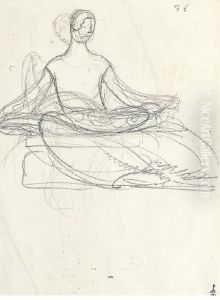Libero Andreotti Paintings
Libero Andreotti was an influential Italian sculptor, born in Pescia, Tuscany, in 1875. Known for his remarkable versatility and innovation, Andreotti played a significant role in the development of early 20th-century Italian sculpture. His work, characterized by a unique blend of classical tradition and modernist experimentation, contributed significantly to the art movements of his time, including Symbolism, Art Nouveau, and later, a return to a more classical formality.
Andreotti received his artistic training at the Academy of Fine Arts in Florence, where he was deeply influenced by his teachers and the rich artistic culture of the city. Early in his career, he embraced the Art Nouveau style, creating works that emphasized flowing lines and natural forms. However, as his career progressed, his style evolved, showing an increased interest in classical sculpture and the human figure, which he represented with a more stylized and less naturalistic approach.
Throughout his career, Andreotti was celebrated for his technical skill and his ability to infuse his sculptures with a sense of emotion and psychological depth. His most famous works include public monuments and memorials, as well as smaller, more intimate figures and busts. Andreotti's sculptures were widely exhibited during his lifetime, both in Italy and internationally, earning him considerable acclaim.
Despite his success, Andreotti remained deeply connected to his Tuscan roots, and his work often reflected the cultural heritage and artistic traditions of his homeland. He was a prominent figure in the Italian art scene until his death in Pescia in 1933. Today, Andreotti's legacy lives on, and his sculptures are held in numerous public and private collections around the world, continuing to be celebrated for their beauty and emotional resonance.


